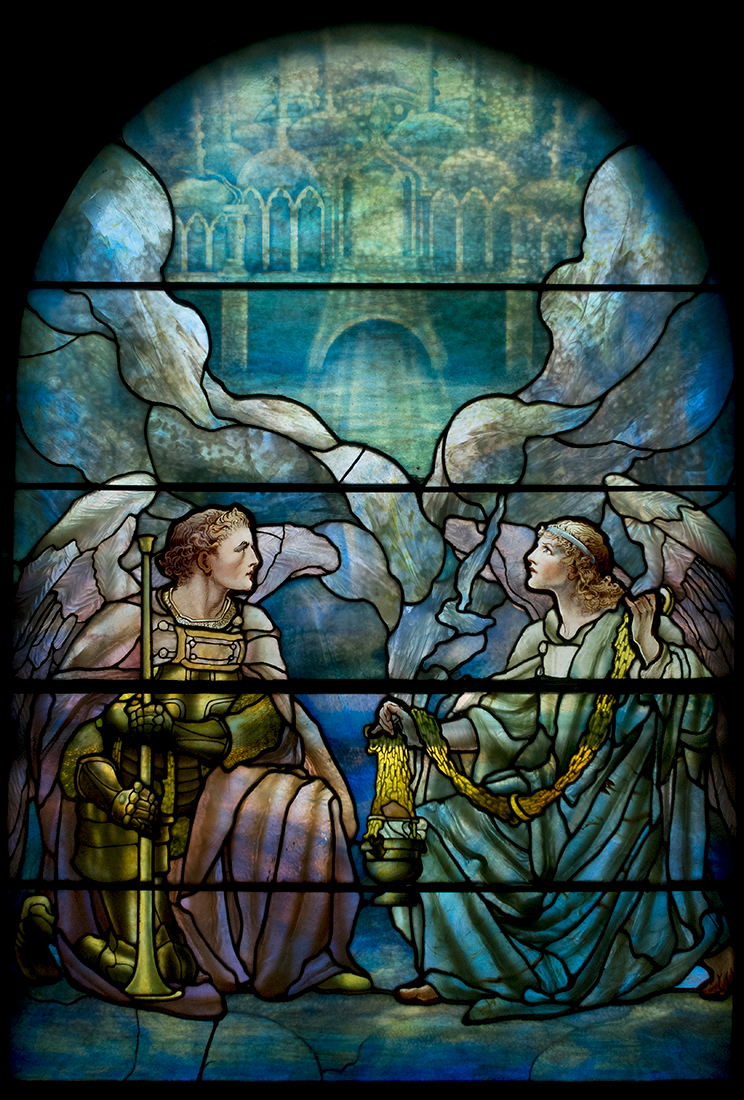
Upper Subject: Angels with Trumpet and Incense
Inscription: none
Dedication: In memory of Rawleigh W. Downman, 1860-1881 and James H. Downman, 1862-1911, sons of William Yates and Mary Ann Downman.
Maker/Date: Tiffany Studios, New York, 1912. This was the first Tiffany installed at St. George’s in 1912.
Description: Tiffany Studios produced three windows for Saint George’s Episcopal Church between 1912 and 1917. Each was intended as a memorial to specific members of the congregation, the earliest being the double window installed in 1912 on the left side of the nave.
Unlike the other Tiffany windows at St. George’s where only the lower portion of the window was created by Tiffany, this window has two separate Tiffany windows.
Donor: Mary Ann Downman was 90 years old in 1923, living in the same home that she was married and was the oldest person in Fredericksburg at the time.
She had six children, three that predeceased her. One child Rev John Yates Downman (1858-1949) became rector at St. Paul’s Episcopal in Richmond. The window was dedicated to two of her sons who had predeceased her. Rawleigh Downman died at age 21 visiting an uncle in Baltimore when he died. James Downman was a successful New York businessman who had suffered a stroke and returned to his sister Nannie’s home. There he was the victim of a hunting accident.
Description – The subject of this window is from the Book of Revelation 9:13 – “The sixth angel blew his trumpet; and I heard a single voice speaking from among the horns of the golden incense altar which is in the presence of God.”
There are seven trumpets in Revelation, each signaling the issuing of God’s judgment on earth. Angels bring God’s judgment on earth in Revelation. The blowing of these trumpets may correspond to the New Moon (or New Month) festivals in the Old Testament. Each new moon trumpet blowing was understood as a day of judgment in miniature, which warned people to prepare for the final judgment ushered in by the Feast of Trumpets and to call people back to a covenant relationship with God. When the seventh trumpet blew, it was to announce the Day of Atonement was at hand.
Before the seventh angel blew his trumpet in Revelation 11, John was asked by a mighty angel (with right foot on the sea and left foot on the land) to eat the scroll telling of the things to happen (first tasting like honey, then souring his stomach) and yet to continue to prophesy further. John was told that the “holy city” (Jerusalem) would be trampled for “42 months,” during which two prophets/witnesses would tell about God, then would be killed, and would rise to heaven after 3 1/2 days — with an earthquake collapsing a tenth of the city.
This image captures the calm before the storm— the angel on the left is the seventh trumpeter, and the angel on the right bears incense. Behind the kneeling angels, billowing cloud rises up, parting at the top to reveal a glistening vision of Jerusalem. The hair and faces are painted with reddish hair that is particularly noticeable.
Techniques – The upper window shows the city of Jerusalem, coming down from heaven, emerging from a backdrop of the opalescent glass of blues, browns, and greens. The Jerusalem image fades into the background. The city shows buildings with columns and onion skin domes.
The city was painted onto a sheet of colored glass with enamel. A sheet of spotted glass was then laid or plated on top, creating a sense of sunlit distance. The spotted glass was made by adding fluorine during the firing process— the fluorine crystallized and caused the spots. Drapery glass is used to produce ripples of varying hues and tints in the angels’ gowns. This type of glass has been bent and folded to produce ripples that create an illusion of depth. The solemn pose of the angels contrasts with the iridescent glimmer of the city that hovers above, instilling the design with surreal grandeur and a sense of what is to come.